Supporting action on the ground
Ecological corridor pilot projects
Parks Canada supported several ecological corridor initiatives as pilot projects as the National Program for Ecological Corridors was being developed. This early action on the ground contributes to our overarching goals to halt and reverse biodiversity loss and fight climate change.
Pilot projects
- Indigenous-led West Coast Stewardship Corridor (British Columbia)
- Radium Wildlife Overpass (British Columbia)
- Highway 3 Wildlife Mitigation Project (British Columbia and Alberta)
- Cootes to Escarpment EcoPark System Ecological Corridor Pilot Program (Ontario)
- Hundred Acres Wood (Quebec)
- Ecological connectivity around La Mauricie (Quebec)
- Consolidation of the Forillon Ecological Corridor (Quebec)
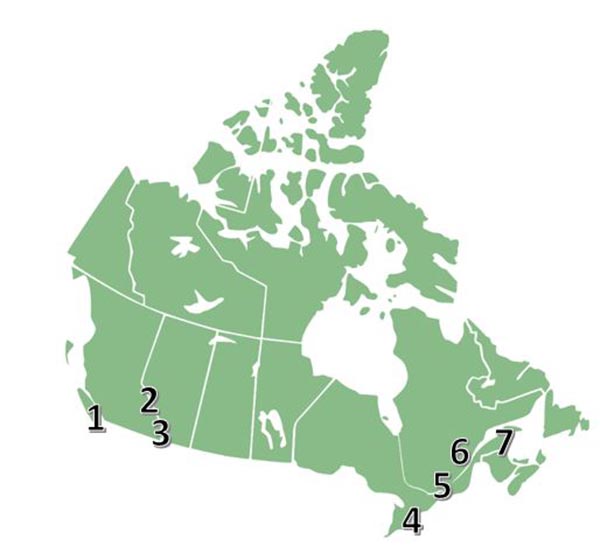
Map description
This map identifies the locations of seven pilot-projects for ecological corridors in Canada.
- The Indigenous-led West Coast Stewardship Corridor project is indicated by the number 1 on the southernmost tip of Vancouver Island in British Columbia
- The Radium Wildlife Overpass project is indicated by the number 2 in the Radium Hot Springs village area, just southeast of the border between British Columbia and Alberta
- The Highway 3 Wildlife Mitigation Project is indicated by the number 3 on the border between British Columbia and Alberta, close to the United States
- The Cootes to Escarpment EcoPark System Ecological Corridor Pilot Program is indicated by the number 4 at the southeastern tip of Lake Ontario in Ontario
- The Hundred Acres Wood project is indicated by the number 5 in southwest Quebec, next to Gatineau park
- The Ecological connectivity around La Mauricie project is indicated by the number 6 in south central Quebec
- The Consolidation of the Forillon Ecological Corridor Project is indicated by the number 7 at the eastern tip of the Gaspé peninsula
Indigenous-led West Coast Stewardship Corridor
British Columbia
Recipient: T’Sou-ke Nation
This contribution supports the Indigenous-led West Coast Stewardship Corridor, by enabling:
- outreach of First Nations leadership
- a regional gathering of Nations whose territories are within the corridor
- a communications plan
- on-the-ground conservation activities
- youth training
- a gap analysis
- mapping
- a road map for the future of the project
The Indigenous-led West Coast Stewardship Corridor is an initiative aimed at restoring and rebalancing healthy relationships with the land, waters, plants, animals, people, and Creator. It is grounded in:
- the Nuu-chah-nulth guiding principles of:
- Hishuk’ish tsawalk (interconnectedness)
- Uu-a-thluk (the responsibility to take care of)
- ʔiisaak' (respect for all things living and nonliving)
- the Coast Salish principle of Naut’sa mawt (together as one)
The Stewardship Corridor aims to unite Indigenous and non-Indigenous land and water stewards. Peoples from across the west coast of Vancouver Island will come together to collaborate, share knowledge, and plan for greater ecological, cultural, spiritual, and economic connectivity.
Radium Wildlife Overpass
British Columbia
Recipient: British Columbia Ministry of Transportation and Infrastructure
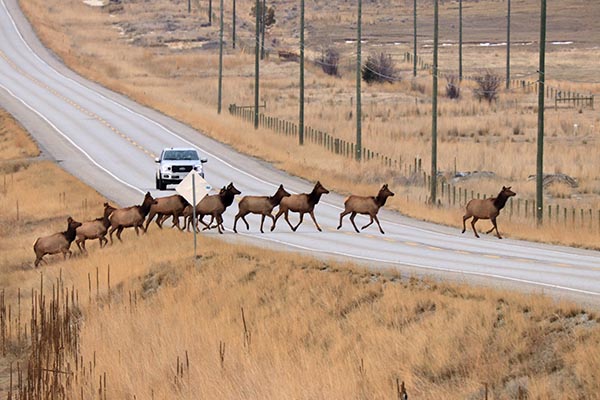
© Ian Adams
This contribution supported a small portion of the Province of British Columbia’s Ministry of Transportation and Infrastructure Radium Wildlife Overpass project. This will include approximately 6 kilometres of wildlife fencing and gates to guide animals to the overpass and safely over the highway.
The contribution allowed partners to finish the detailed design of the overpass structure. It supported an agreement between the Ministry and the Shuswap Band, which now has capacity for the construction of the wildlife fencing.
The project aims to improve the ecological connectivity in the Radium Hot Springs Village area for vulnerable bighorn sheep. The corridor will help reduce habitat separation caused by Highway 93.
Highway 3 Wildlife Mitigation Project
Alberta and British Columbia
Recipient: Yellowstone to Yukon Conservation Initiative (Y2Y)
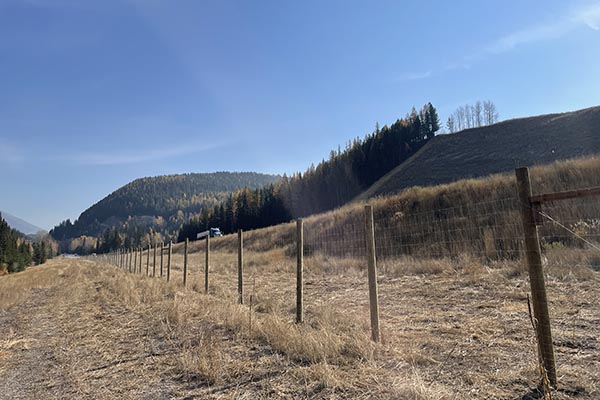
© Reconnecting The Rockies BC
This contribution supports the Highway 3 Wildlife Mitigation project, by enabling:
- infrastructure projects
- communications and outreach
- wildlife research
- engagement, including Indigenous engagement
The project aims to improve ecological connectivity within the Cabinet-Purcell Mountain and Crown of the Continent ecological corridors in Alberta and British Columbia. This involves addressing the division caused by Highway 3.
The Crown of the Continent ecosystem is one of the important landscapes within the 3,400-km-long Yellowstone to Yukon region. It provides crucial habitat and connections for grizzly bears, wolverines, and other wide-ranging wildlife between protected areas in the U.S. and Canada.
Roads are a major barrier to wildlife movement. Increased traffic on Highway 3, coupled with the growth of various industries, tourism, and development, has posed challenges to this critical ecosystem. This traffic hinders wildlife movement and contributes to a rise in wildlife-vehicle collisions.
Recognizing these issues, the provincial governments of B.C. and Alberta are implementing solutions to this problem. Wildlife corridors and crossings are proven to work. They link habitat areas on either side of the highway, allowing animals to migrate, recolonize, and breed, benefiting biodiversity. Recommendations from scientists, researchers, and local stakeholders who hold valuable knowledge and experience play a key role.
This pilot project represents a significant step forward in creating a safer route for people, and a more connected corridor for wildlife.
Cootes to Escarpment EcoPark System Ecological Corridor Pilot Program
Ontario
Recipient: Royal Botanical Gardens
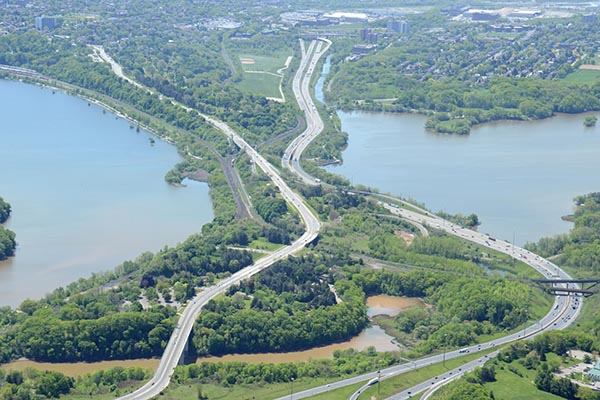
© David A. Galbraith
The Cootes to Escarpment EcoPark System is a voluntary park alliance in Hamilton and Burlington, Ontario. Partners own protected areas that connect the Niagara Escarpment with Lake Ontario coastal wetlands within a fragmented urban landscape.
EcoPark System partners manage their own lands and collaborate on shared ecological connectivity priorities. This contribution to the EcoPark System Ecological Corridor Pilot Program supports:
- engagement with neighboring landowners
- land securement opportunities
- restoration of critical habitat
- building relationships with Indigenous Communities
Partners include the:
- Bruce Trail Conservancy
- City of Burlington
- City of Hamilton
- Conservation Halton
- Halton Region
- Hamilton Conservation Authority
- Hamilton Naturalists' Club
- McMaster University
- Royal Botanical Gardens
Hundred Acre Wood Project
Quebec
Recipient: Action Chelsea for the Respect of the Environment (ACRE)
This contribution supported the purchase of the Hundred Acre Wood property next to Gatineau Park. ACRE is working to maintain the ecological connectivity of the park by connecting it to an area of core habitat.
The Hundred Acre Wood property is a forested area that is a key part of the North-East Ecological Corridor identified by Gatineau Park. The corridor is home to ten bird species at risk and many mammal species of interest, including white-tailed deer, snowshoe hare, Canada lynx, American marten, American black bear, and partridge.
ACRE is a non-profit organisation made up of concerned citizens working towards an environmentally healthy community. They work to protect the ecological integrity of Chelsea Quebec, and to increase understanding and awareness of ecological integrity and its importance in enhancing our quality of life. ACRE currently has ten conservation properties and has secured lands in three of the ecological corridors identified by Gatineau Park.
Ecological connectivity around La Mauricie National Park
Quebec
Recipient: The Nature Conservancy of Canada (NCC)
This contribution supported the protection of two essential natural habitats for at-risk wood turtles in the Mauricie region. Covered in forest-lined riversides and wetlands, these properties offer much-needed habitat for wood turtles to feed and find mates, as well as critical sites for the survival of this species in Canada. Covering 115 hectares, the two sites are linked to La Mauricie National Park and other areas protected by NCC through the region's extensive natural landscapes. This connectivity allows wood turtles and other animals to migrate and ultimately meet their survival needs.
This project was made possible by the participation of:
- the Quebec government
- Construction DJL inc.
- the Government of Canada
- Fondation de la faune du Québec
- the U.S. Fish and Wildlife Service
The Nature Conservancy of Canada (NCC) is the country’s unifying force for nature. NCC seeks solutions to the twin crises of rapid biodiversity loss and climate change through large-scale, permanent land conservation. NCC is a registered charity. With nature, NCC is building a thriving world.
Consolidation of the Forillon Ecological Corridor
Quebec
Recipient: The Nature Conservancy of Canada (NCC)
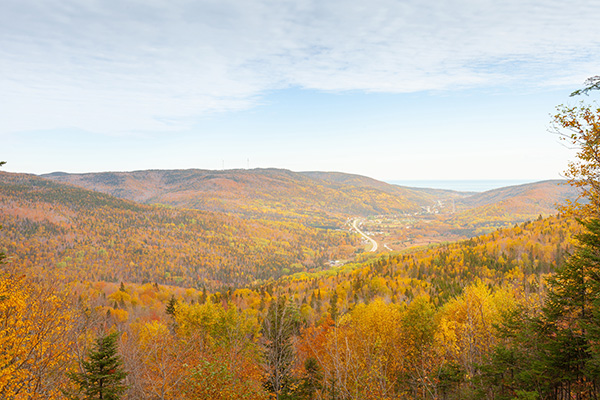
©Parks Canada/Roger St-Laurent
The Forillon Ecological Corridor is a forested area that provides ecological connectivity between Forillon National Park and the large forests in the heart of the Gaspé Peninsula. On its own, Forillon National Park is too small to ensure the long-term maintenance of some of its wildlife populations. Route 197 forms the western boundary of the park and is a barrier to the safe passage of animals in and out of the protected area. The corridor is therefore important for wildlife movement and security, but also facilitates the migration of many species so they can adapt to climate change.
This contribution supports:
- protecting priority conservation lands
- assessing priorities for the conservation of additional lands
- collaborating with local partners, such as Nation Micmac de Gespeg and the team at Forillon National Park to further research and knowledge gathering
- improving the safety of route 197 for human-wildlife coexistence
- education, citizen science, and monitoring with communities and landowners to improve ecological connectivity
The Forillon Ecological Corridor project and the Connectivity around La Mauricie projects are part of the Quebec Ecological Corridor Initiative (IQCÉ), a collective approach to the protection of biodiversity and ecological corridors. The initiative is made up of 10 organizations from 11 regions of Quebec, and supported by around 100 experts and stakeholders.
- Date modified :